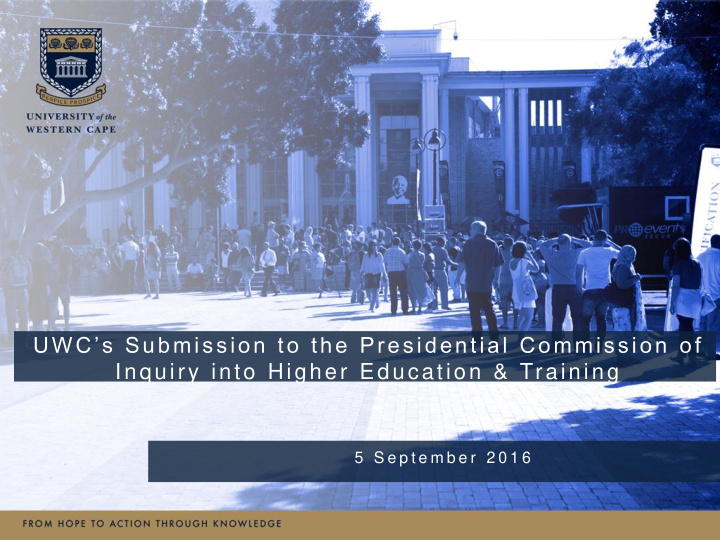



UWC’s Submission to the Presidential Commission of Inquiry into Higher Education & Training 5 S e p t e m b e r 2 0 1 6
Contents • Historical context • UWC’s financial recovery • Financial viability & nature of UWC challenges • Academic standing & profile • Conclusion
UWC’s historical context
Seas ons of c hange • 1960s – Founded. Studies under duress • 1970s – Student resistance, Black Consciousness, Soweto Uprising, institutional autonomy • 1980s – Repudiated ideological grounds, “Intellectual home of the Left” and vanguard of struggle and institutional transformation • 1990s – Democratisation, bankruptcy, retrenchments • 2000s – Consolidation, recapitalisation (2005), recognised as research-intensive, infrastructure expansion
The precarious 90’s •1995: Minister’s call for zero fee increases to allow indigent students to register without paying • Increased student debt without state support • Dwindling student numbers • 1998 UWC became insolvent, 41 academics and 300 non-academic staff retrenched as a result
Financial challenge of the 90’s Employment cost and subsidy income relationship unsustainable
UWC’s financial recovery:2001 -2008
UWC’s financial realities
UWC’s financial realities
UWC’s financial realities
Recovery plan • R170 million recapitalisation fund from the state • Focus on academic excellence in key research niche areas • Enabled UWC to attract donor funding • Gradual and consistent fee increases (above inflation) • Investment in physical infrastructure • Improved reputation as a place to grow, from hope to action through knowledge • Concerted effort to grow student numbers (10 000 – 21 548)
Financial viability and nature of the UWC challenges
Indigent student profile 69 % of UWC students had to be financially cleared to enable them to register in 2016
Declining state subsidy to HE
UWC’s low fee base Residence BA BCom BSc LLB fees (double Mock calculation* room) UWC R25 300 R25 300 R28 000 R25 300 R16 000 R 533 000 000 Stellenbosch R32 500 R40 000 R40 750 R39 600 R29 500 R 791 750 000 University (=UWC + 49%) UCT R46 000 R56 520 R50 000 R46 500 R38 500 R 1 047 350 000 (=UWC + 97%) Mock calculation is based on each university having: 5000 BA students; 5000 BCom students ; 8000 BSc students; 2000 LLB students & 3500 students in double rooms in residences
Academic standing & profile
Doing well but financially vulnerable Source: CHET 2016
Increased research capacity and output Research output 2002 - 2015 1200 1000 800 600 400 200 0 2002 2004 2006 2008 2010 2012 2013 2014 2015* Publication units Research Master’s Doctoral Weighted total
Overview: Impact and recognition • Times Higher Education ranking of top 30 African Universities UWC: 7 th in Africa and 5 th in South Africa (2015) • Highly acclaimed QS Ranking only included 5 SA Universities in 2015 & UWC was one of them • Nature Index Ranked UWC number 1 in SA in Physics research output in 2016 • First HDI to be awarded a NRF/DST Flagship in humanities • 13 NRF/DST SARChI chairs • NRF/DST Centre of Excellence in Food Security
Achievement in research 13 August 2016 • x First African university to have an experiment to run at the European Centre for Nuclear Research, the holy grail for science research.
Innovation to improve the quality of life Computer science students won the Standard Bank undergraduate computer science competition. They won R100000 for UWC. They designed an app for sight impaired people to access computerized banking.
Conclusion
Conclusion • UWC supports free education for the poor (including the “missing middle”) • State funding through subsidy has declined by 11 % since 2000. If financial support for poor students is provided for by the State in accordance with current rate of subsidy funding increases, this will result in financial loss in real terms Higher education inflation is higher than general inflation Due to the high proportion of UWC students dependent on NSFAS and other financial support measures, UWC could face severe financial challenges Fee-free higher education must factor in the annual increases on income required by universities to support academic success and research activities (not one-size fits all) • If funded at the appropriate level, free access to higher education for the poor will support HDIs: improved cash flow, lower levels of student debt
Baie dankie, eNkosi, Thank you!
Recommend
More recommend